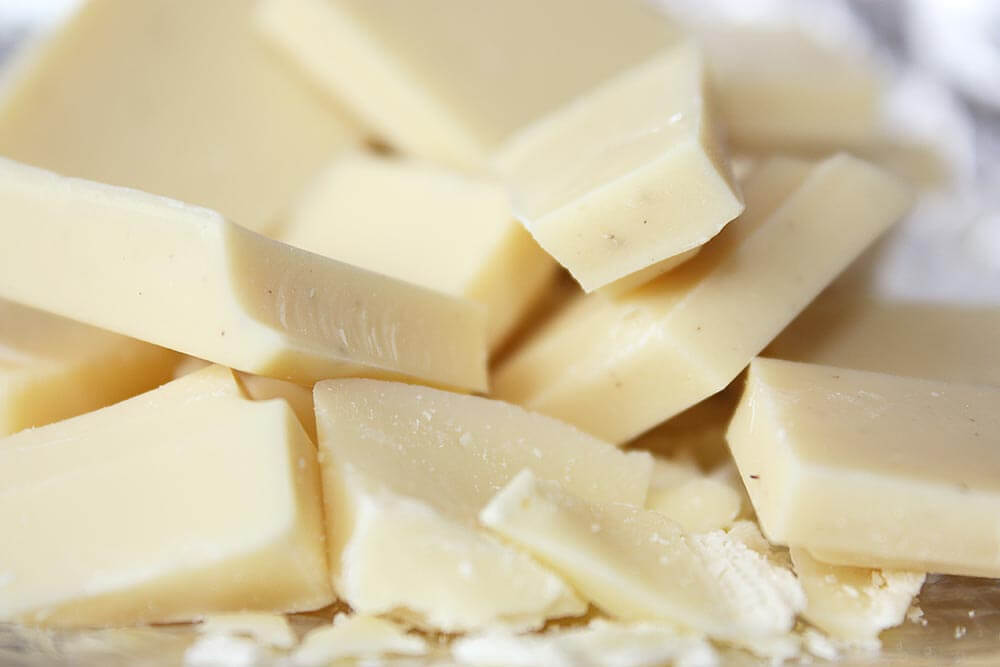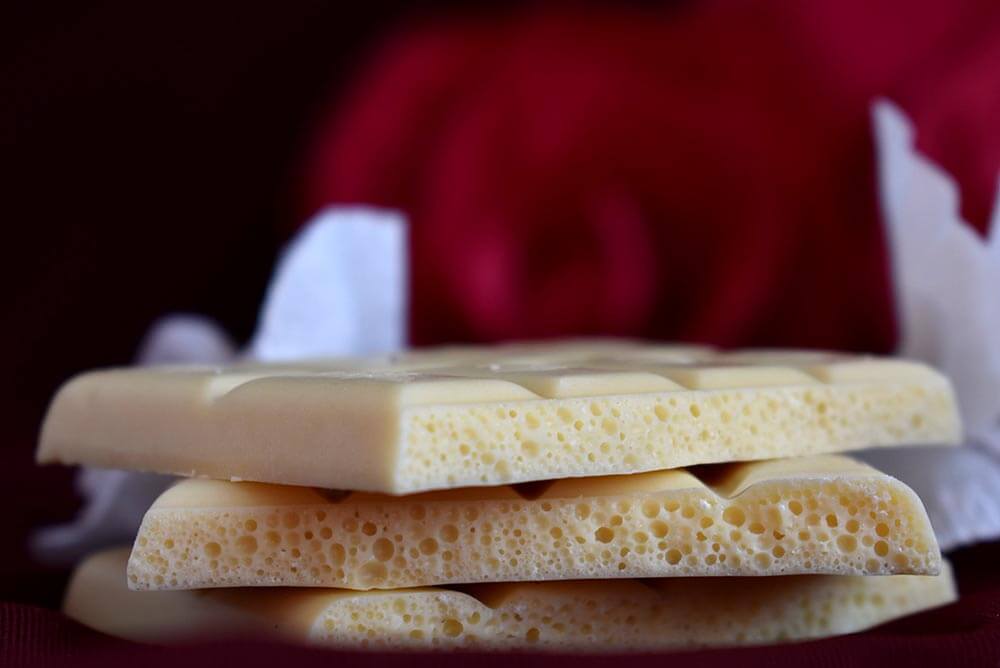It’s a well-known fact that chocolate is toxic to dogs.
But what about chocolate’s paler, equally luscious cousin, white chocolate?
Here’s the good news: white chocolate isn’t as toxic to dogs as the brown varieties.
The bad news: white chocolate still isn’t good for dogs. In fact, we highly recommend you don’t feed your dog white chocolate.
In today’s article, we’ll discuss why white chocolate is bad for our furry friends. So read on!

What is white chocolate?
Named after its distinctive ivory hue, white chocolate is a type of chocolate candy typically consisting of cocoa butter, milk, and sugar.
White chocolate is one of three main types of chocolate, the other two being milk chocolate and dark chocolate.
What sets white chocolate apart from the other types? It lacks cocoa solids/powder.

Theobromine: why white chocolate might poison your dog
Theobromine, an organic compound found in cocoa, is what makes chocolate toxic to dogs. If a dog eats chocolate, this compound can wreak havoc on their cardiovascular, respiratory, and central nervous systems, resulting in a variety of problems that can culminate in death.
White chocolate also contains theobromine.
However, because white chocolate doesn’t have cocoa solids, its theobromine content is too low to harm a dog. A dog has to eat this candy frequently or in enormous quantities to get poisoned.
Unfortunately, there are white chocolate brands that do contain cocoa solids and therefore greater amounts of theobromine. A pet owner who doesn’t read food labels may end up feeding this type of white chocolate to their dog, resulting in toxicity.
You should also consider your dog’s size. A piece of white chocolate that’s small for a big dog may be large enough to harm a puppy or small-breed dog.
The initial symptoms of theobromine poisoning include vomiting with or without blood, severe thirst, extreme excitability, exaggerated reactions to stimuli, an abnormally fast heartbeat, excessive panting, uncoordinated movements, and muscle twitching.
As the poisoning grows worse, a dog may experience seizures, cardiac arrhythmias (irregular heartbeat), and death.
Symptoms can manifest within 2 hours of theobromine ingestion. However, there are cases of dogs not showing any symptoms until 24 hours after ingestion.

Sugar: why white chocolate is bad for dogs
Like the other two main types of chocolate, white chocolate is high in sugar. This is bad for dogs.
If your dog eats white chocolate, they may experience the following issues:
Digestive problems
Dogs need sugar to stay healthy. However, they typically obtain this sugar from the carbohydrates they ingest. The sugar that’s found in candy isn’t natural to canines, which is why white chocolate can create chaos in your dog’s sensitive digestive system.
A dog that eats white chocolate can therefore end up suffering from digestive problems whose symptoms include stomach upsets, stomachaches, gas, diarrhea, and vomiting. The severity of these symptoms can range from mild to extreme, with the latter requiring treatment by a vet.
White chocolate’s high sugar content can make your dog pack on additional pounds. If your dog eats lots of this candy, they may even grow obese.
Obesity makes a dog increasingly prone to joint pain and fractures, back issues, and serious medical conditions such as diabetes and heart disease. Further compounding the problem is the fact that extremely heavy dogs face many difficulties whenever they move around, which discourages the exercise they need to lose weight and become healthier.
If a dog owner wants their beloved fur baby to live a long and happy life, they must ensure their pet maintains a weight ideal for their size and breed.
Elevated blood sugar levels
When a dog eats an abundance of sugary white chocolate, their blood sugar levels rise, which can result in dehydration, extreme thirst, depression, lower energy levels, seizures, or even a coma.
Having elevated blood sugar levels for extended periods can increase the risk of various medical issues, among them kidney disease, heart disease, stroke, and possibly even diabetes.
Pancreatitis
When your dog consumes sugar, their pancreas produces insulin, which breaks down the sugar to bring the elevated blood sugar levels back to normal.
When a dog eats plenty of white chocolate, the pancreas is placed under extreme pressure to break down all that excess sugar. This can result in pancreatic damage or inflammation, also known as pancreatitis.
Symptoms of pancreatitis include nausea, vomiting, diarrhea, dehydration, depression, abdominal pain, poor appetite, lethargy, and fever. Untreated pancreatitis can lead to death.
Sugar addiction
If you feed your dog white chocolate regularly, they may become addicted to its sugar. A sugar-addicted dog may refuse to eat healthier foods and demand to be fed white chocolate only. Without proper nutrition, your dog’s health takes a nosedive, leaving them susceptible to myriad infections and illnesses.
Dental cavities
When your dog consumes sugary food, their mouth bacteria release acid to break down the sugar. The more sugar ingested, the more acid produced.
Eating white chocolate therefore encourages the production of excess acid, which, over time, can erode enamel (the hard outer layer of the teeth), creating holes in the teeth known as cavities. If left untreated, cavities can lead to the loss of teeth.

What to do if your dog eats white chocolate
Let’s say your dog eats some white chocolate. What do you do?
The first thing you should do is check the food label. Does the candy contain only a trace of theobromine? Then don’t panic. Unless your dog eats a whole bunch of candy bars, then your dog will likely be fine. You should still contact your dog’s vet, however, as they know what’s best for their patients.
The second thing you should do is to prepare yourself for the possible consequences of sugar consumption. While one dog may experience no problems after eating a bite or two of white chocolate, another may vomit all over the floor or end up with diarrhea.
If your dog gets sick due to sugar overload, your vet can give you instructions regarding what to do next. You’ll likely be told to refrain from feeding your dog for at least 12 hours and to hydrate them by providing them with a moderate amount of clean, fresh drinking water. If there are no other instances of vomiting and diarrhea, your dog should be able to start drinking more and eating small servings of bland, low-fat food. Have them keep eating this food around 3 times a day for a couple of days.
If the vomiting and diarrhea persist or if any other symptoms arise, bring your dog to the vet immediately.
Theobromine poisoning
But what if your dog eats white chocolate with high theobromine content?
Examine the food label, then contact your vet and tell them how much theobromine the sweet contains. They’ll determine whether or not your pet needs emergency treatment at the clinic.
You should also contact your vet if your dog manages to ingest significant quantities of white chocolate.
Treating theobromine toxicity is a multistep process. Among the first things your vet will do is induce vomiting in your dog. They’ll also likely have your dog swallow activated charcoal, which will absorb the poison from their system. Depending on the severity of the poisoning, your vet may also administer heart medications, intravenous fluids, antacids, and more. Your dog may have to stay at the clinic for at least one night for continued observation and treatment.
Prevention
To prevent your dog from ingesting white chocolate and other potentially dangerous foods, always store them where your dog can’t see and reach them. Try putting them in the fridge or the cupboards above the kitchen counter. If your dog’s the type of pooch that can climb kitchen counters and open refrigerators, lock the kitchen door whenever you’re not at home.
Ensure your vet’s phone number and address can be easily accessed by everyone in your family. It would be best for every family member to have this information stored in their smartphone. You can also write the information down on a piece of paper, then stick the paper onto a wall or the refrigerator.
Should the vet be unavailable during a time of crisis, pet owners in North America can contact the Pet Poison Helpline at (855) 764-7661 or Animal Poison Control at (888) 426-4435.

Conclusion
White chocolate may be an exquisite treat for us people, but for dogs, it can be a one-way ticket to the vet.
Don’t feed dogs white chocolate. Even varieties that don’t contain much theobromine can make your pet sick. There are so many healthier options they can enjoy, so make sure to ask your vet what to give your dog the next time you want to reward them with a sweet treat!
